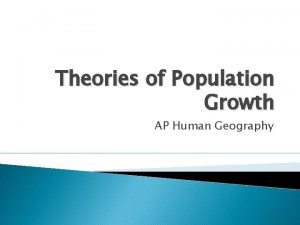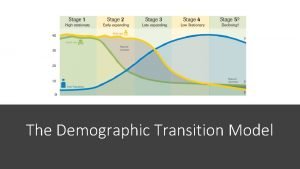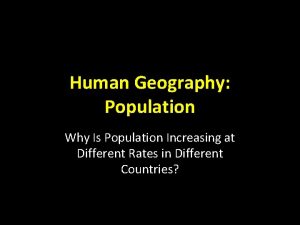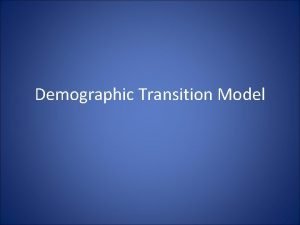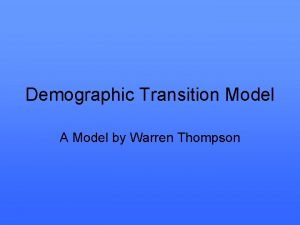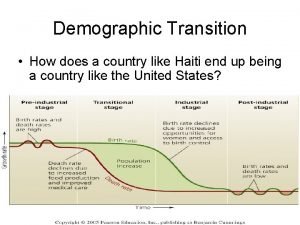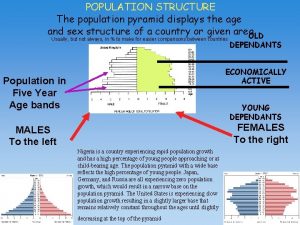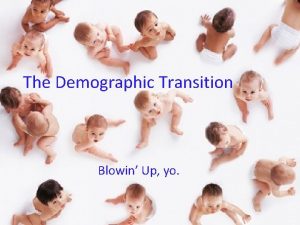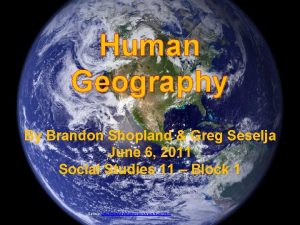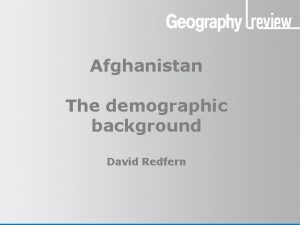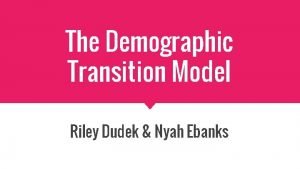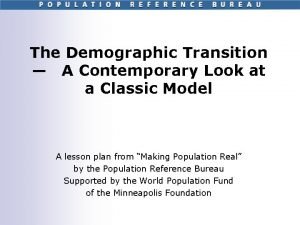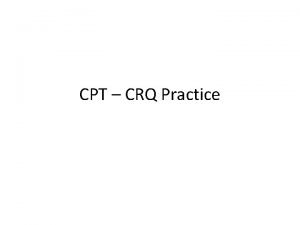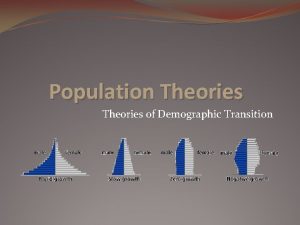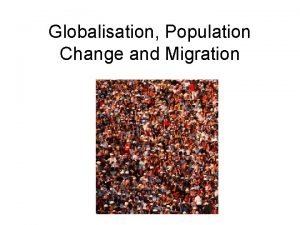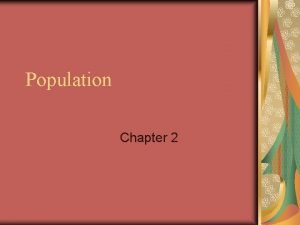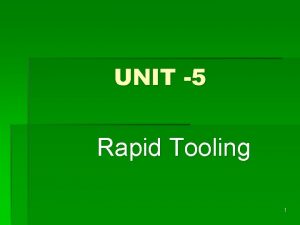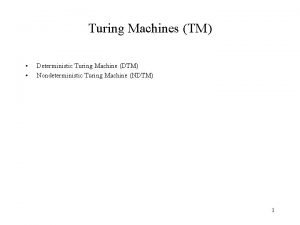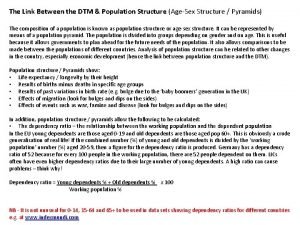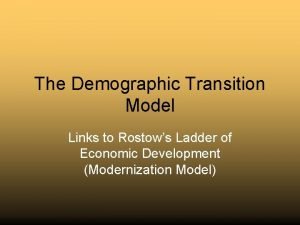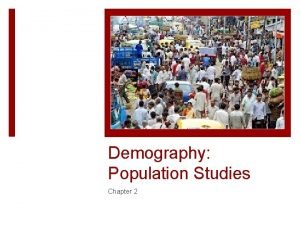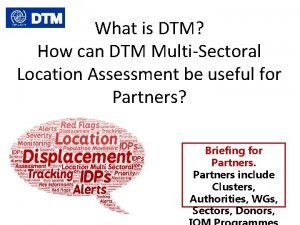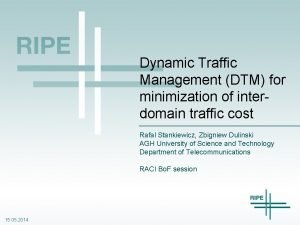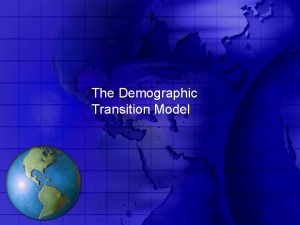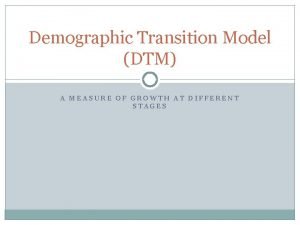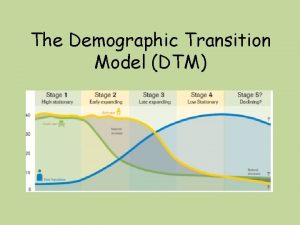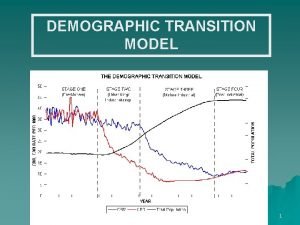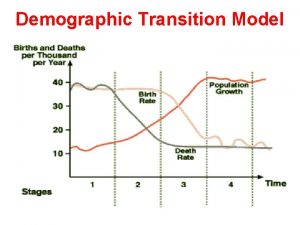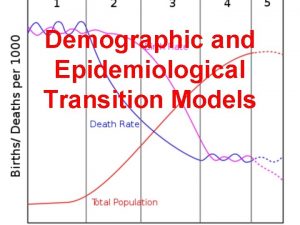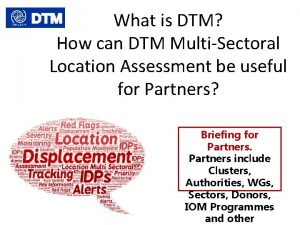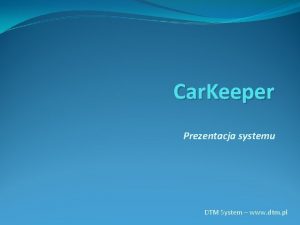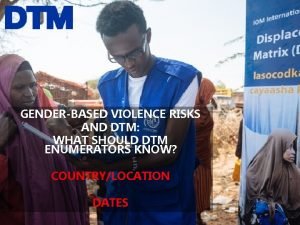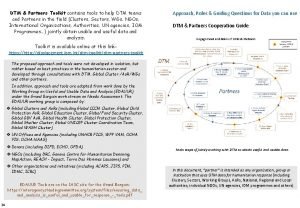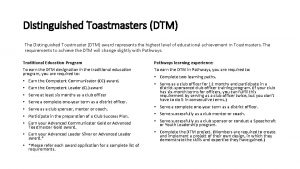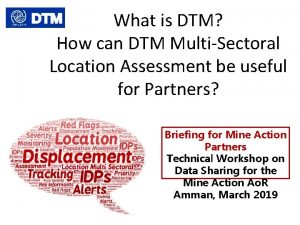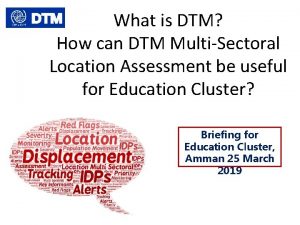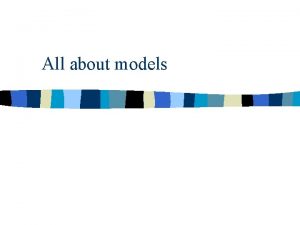CRQ Demographic Transition Model Demographic Transition Model DTM


































- Slides: 34

CRQ: Demographic Transition Model

Demographic Transition Model (DTM) The demographic transition model attempts to describe and predict how a population will change over time as it changes from an agrarian society to an industrial, and post-industrial society.

Key terms in the DTM: • Crude Birth Rate (CBR) • Crude Death Rate (CDR) • Natural Increase Rate (NIR) • Total Fertility Rate (TFR) • Infant Mortality Rate (IMR) • Life Expectancy

CBR: total number of live births in a year for every 1, 000 people alive in the society CDR: the total number of deaths in a year for every 1, 000 people alive in the society NIR: the percentage growth of a population in a year, computed as the crude birth rate minus the crude death rate TFR: the average number of children a woman will have throughout her childbearing years IMR: the total number of deaths in a year among infants under 1 year old for every 1, 000 live births in a society Life Expectancy: the average number of years an individual can be expected to live, given current social, economic & medical conditions. Life expectancy at birth is the average number of years a newborn infant can expect to live.

The Demographic Transition n ul p Po io at

n ul p Po Stage 1: high, fluctuating CBR and CDR / near zero (. 05% NIR), population low io at

Human society has been in stage 1 for most of human history.

n ul p Po Stage 1: high, fluctuating CBR and CDR / near zero (. 05% NIR), population low io at Stage 2: CDR falls, CBR remains high, increasing NIR and rapid population growth


It’s easy to see when the world entered stage 2: around 1800 with the Industrial Revolution.

n ul p Po Stage 1: high, fluctuating CBR and CDR / near zero (. 05% NIR), population low io at Stage 2: CDR falls, CBR remains high, increasing NIR and rapid population growth Stage 3: CDR decline slows, CBR falls, NIR falls, population growth slows

n ul p Po Stage 1: high, fluctuating CBR and CDR / near zero (. 05% NIR), population low io at Stage 2: CDR falls, CBR remains high, increasing NIR and rapid population growth Stage 3: CDR decline slows, CBR falls, NIR falls, population growth slows Stage 4: Low CDR and CBR, low NIR, stable (but now large) population




MDC’s (More Developed Countries) have already moved into stages 3 and 4. As LDC’s (Less Developed Countries) move into stages 3 and 4, total world population will level off at around 12 billion people sometime around the year 2100.

How has each of the following states challenged the DTM (Demographic Transition Model) during the time periods listed? a. South Korea (1945 -present) b. Niger (present) c. Zimbabwe (late 1990’s-early 2000’s) d. Japan (1945 -present)

AIDs in southern Africa: DTM in reverse?

Niger: Stuck in the “Demographic Trap”?

South Korea Raced through Stage II:

Japan: Time for a Stage 5 in the DTM!

Population Demographic transition model The demographic transition model shows how a population will change over time as it changes from an agrarian society to an industrial, and postindustrial one. Stage 1. Birth and death rates are both high, leading to a low but stable population. High fluctuating UK pre 1760/Industrial Revolution. Remote tribal groups presently.

Population Demographic transition model The demographic transition model shows how a population will change over time as it changes from an agrarian society to an industrial, and postindustrial one. Stage 2. Birth remain high but now death rates start to fall dramatically, leading to a rising population. Early expanding UK pre 1760 -1880. Peru/Sri Lanka/Kenya presently.

Population Demographic transition model The demographic transition model shows how a population will change over time as it changes from an agrarian society to an industrial, and postindustrial one. Stage 3. Birth start to fall now and death rates continue to fall, causing the population to continue to rise but less quickly now as the gap between births and deaths is closing. Late expanding UK 1880 -1940 China/Cuba/Australia presently.

Population Demographic transition model The demographic transition model shows how a population will change over time as it changes from an agrarian society to an industrial, and postindustrial one. Stage 4. Birth and death rates are now both low, causing the population to be more stable but high. Low fluctuating UK post 1940 Canada/USA/Japan.

Stage 1 – High Fluctuating High CBR • Reasons: High IMR Lack of family planning Need for workers Children are economic assets(support parents) • Religious beliefs • • • Roman Catholics • Muslims • Hindus High CDR • Reasons: • • • Disease Famine War Poor hygiene & sanitation Lack of healthcare Lack of education

Population Demographic transition model Stage 1. Natural increase (population growth) is low because although there a lot of births the similarly high number of deaths effectively cancels them out, leaving a low but stable population.

Stage 2 – Early Expanding • Same reasons as Stage 1 High CBR Declining CDR • Reasons: • • • Improved healthcare Improved sanitation Improved food production Decreasing IMR Outside stimulus

Population Demographic transition model Stage 2. Natural increase (population growth) is high because there is now a large gap between births and deaths, increasing the population rapidly.

Stage 3 – Late Expanding • Same reasons as Stage 2 Declining CBR Reasons: ◦ Changing status of women ◦ ◦ Cairo Conference Availability of family planning Lower IMR Increased standard of living Better technology = lower demand for workers ◦ Welfare/Retirement Declining CDR

Population Demographic transition model Stage 3. Natural increase (population growth) remains high due to the gap between births and deaths but at this stage the increase slows as births and deaths match up again.

Stage 4…and 5? Stage 4 – Low Fluctuating • CBR & CDR are low • Population is stable Stage 5 • CBR drops below CDR • Population starts to decrease • Officially only 4 stages • Not part of the original DTM, but some geographers have added it • So if there is 5, why not 6?

Population Demographic transition model Stage 4. Natural increase (population growth) is again low as births and deaths virtually cancel each other out, but now the population is high. .

 Demographic transition model ap human geography
Demographic transition model ap human geography Uk demographic transition model
Uk demographic transition model Epidemiological transition
Epidemiological transition Demographic transition model ap human geography
Demographic transition model ap human geography Chile dtm stage
Chile dtm stage Warren thompson's demographic transition model
Warren thompson's demographic transition model Haiti dtm stage
Haiti dtm stage Demographic transition model stages
Demographic transition model stages Demography ap human geography
Demography ap human geography Demographic transition model population pyramids
Demographic transition model population pyramids Demographic transition model worksheet
Demographic transition model worksheet Demographic transition model song
Demographic transition model song Demographic transition model uk
Demographic transition model uk Afghanistan population 2050
Afghanistan population 2050 Demographic transition model example
Demographic transition model example Demographic transition model
Demographic transition model Crq practice
Crq practice Answer to it
Answer to it Short-answer constructed response questions (crq)
Short-answer constructed response questions (crq) Crq global regents
Crq global regents Crq in project management
Crq in project management Theory of demographic transition
Theory of demographic transition Demographic transition theory
Demographic transition theory Two big breaks in the demographic transition
Two big breaks in the demographic transition Demographic transition
Demographic transition Demographic transition def
Demographic transition def Os terrain 5 dtm
Os terrain 5 dtm Kirksite tooling
Kirksite tooling Difference between dtm and ndtm
Difference between dtm and ndtm Population pyramid dtm
Population pyramid dtm Stages of dtm
Stages of dtm Dtm dynamic tag management
Dtm dynamic tag management Dtm pyramids
Dtm pyramids Candtm
Candtm Dynamic traffic management
Dynamic traffic management
